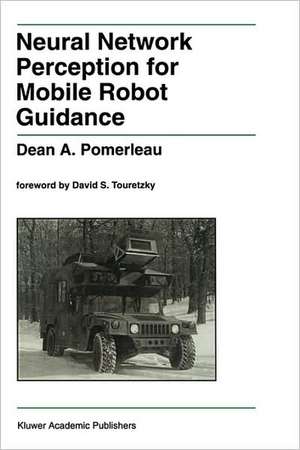Neural Network Perception for Mobile Robot Guidance: The Springer International Series in Engineering and Computer Science, cartea 239
Autor Dean A. Pomerleauen Limba Engleză Hardback – 31 iul 1993
| Toate formatele și edițiile | Preț | Express |
|---|---|---|
| Paperback (1) | 636.30 lei 6-8 săpt. | |
| Springer Us – 28 sep 2012 | 636.30 lei 6-8 săpt. | |
| Hardback (1) | 642.51 lei 6-8 săpt. | |
| Springer Us – 31 iul 1993 | 642.51 lei 6-8 săpt. |
Din seria The Springer International Series in Engineering and Computer Science
- 24%
 Preț: 1041.98 lei
Preț: 1041.98 lei - 20%
 Preț: 643.50 lei
Preț: 643.50 lei - 18%
 Preț: 1225.62 lei
Preț: 1225.62 lei - 18%
 Preț: 965.02 lei
Preț: 965.02 lei - 20%
 Preț: 646.12 lei
Preț: 646.12 lei - 18%
 Preț: 948.79 lei
Preț: 948.79 lei - 20%
 Preț: 646.62 lei
Preț: 646.62 lei - 15%
 Preț: 637.46 lei
Preț: 637.46 lei - 20%
 Preț: 643.83 lei
Preț: 643.83 lei - 18%
 Preț: 949.23 lei
Preț: 949.23 lei - 20%
 Preț: 644.48 lei
Preț: 644.48 lei - 20%
 Preț: 994.92 lei
Preț: 994.92 lei - 20%
 Preț: 645.97 lei
Preț: 645.97 lei - 18%
 Preț: 946.87 lei
Preț: 946.87 lei - 20%
 Preț: 995.57 lei
Preț: 995.57 lei - 18%
 Preț: 956.99 lei
Preț: 956.99 lei - 20%
 Preț: 644.98 lei
Preț: 644.98 lei - 15%
 Preț: 649.54 lei
Preț: 649.54 lei - 18%
 Preț: 950.21 lei
Preț: 950.21 lei - 18%
 Preț: 1221.38 lei
Preț: 1221.38 lei - 18%
 Preț: 957.62 lei
Preț: 957.62 lei - 15%
 Preț: 643.99 lei
Preț: 643.99 lei - 18%
 Preț: 948.47 lei
Preț: 948.47 lei - 18%
 Preț: 947.35 lei
Preț: 947.35 lei - 20%
 Preț: 1284.65 lei
Preț: 1284.65 lei - 20%
 Preț: 1628.31 lei
Preț: 1628.31 lei - 20%
 Preț: 1285.78 lei
Preț: 1285.78 lei
Preț: 642.51 lei
Preț vechi: 755.88 lei
-15% Nou
Puncte Express: 964
Preț estimativ în valută:
122.95€ • 131.47$ • 102.51£
122.95€ • 131.47$ • 102.51£
Carte tipărită la comandă
Livrare economică 18 aprilie-02 mai
Preluare comenzi: 021 569.72.76
Specificații
ISBN-13: 9780792393733
ISBN-10: 0792393732
Pagini: 191
Ilustrații: XV, 191 p.
Dimensiuni: 155 x 235 x 13 mm
Greutate: 0.48 kg
Ediția:1993
Editura: Springer Us
Colecția Springer
Seria The Springer International Series in Engineering and Computer Science
Locul publicării:New York, NY, United States
ISBN-10: 0792393732
Pagini: 191
Ilustrații: XV, 191 p.
Dimensiuni: 155 x 235 x 13 mm
Greutate: 0.48 kg
Ediția:1993
Editura: Springer Us
Colecția Springer
Seria The Springer International Series in Engineering and Computer Science
Locul publicării:New York, NY, United States
Public țintă
ResearchCuprins
1 Introduction.- 1.1 Problem Description.- 1.2 Robot Testbed Description.- 1.3 Overview.- 2 Network Architecture.- 2.1 Architecture Overview.- 2.2 Input Representations.- 2.3 Output Representation.- 2.4 Internal Network Structures.- 3 Training Networks “On-The-Fly”.- 3.1 Training with Simulated Data.- 3.2 Training “on-the-fly” with Real Data.- 3.3 Performance Improvement Using Transformations.- 3.4 Discussion.- 4 Training Networks With Structured Noise.- 4.1 Transitory Feature Problem.- 4.2 Training with Gaussian Noise.- 4.3 Characteristics of Structured Noise.- 4.4 Training with Structured Noise.- 4.5 Improvement from Structured Noise Training.- 4.6 Discussion.- 5 Driving Results and Performance.- 5.1 Situations Encountered.- 5.2 Driving with Alternative Sensors.- 5.3 Quantitative Performance Analysis.- 5.4 Discussion.- 6 Analysis of Network Representations.- 6.1 Weight Diagram Interpretation.- 6.2 Sensitivity Analysis.- 6.3 Discussion.- 7 Rule-Based Multi-network Arbitration.- 7.1 Symbolic Knowledge and Reasoning.- 7.2 Rule-based Driving Module Integration.- 7.3 Analysis and Discussion.- 8 Output Appearance Reliability Estimation.- 8.1 Review of Previous Arbitration Techniques.- 8.2 OARE Details.- 8.3 Results Using OARE.- 8.4 Shortcomings of OARE.- 9 Input Reconstruction Reliability Estimation.- 9.1 The IRRE Idea.- 9.2 Network Inversion.- 9.3 Backdriving the Hidden Units.- 9.4 Autoencoding the Input.- 9.5 Discussion.- 10 Other Applications – The SM2.- 10.1 The Task.- 10.2 Network Architecture.- 10.3 Network Training and Performance.- 10.4 Discussion.- 11 Other Vision-based Robot Guidance Methods.- 11.1 Non-learning Autonomous Driving Systems.- 11.2 Other Connectionist Navigation Systems.- 11.3 Other Potential Connectionist Methods.- 11.4 Other MachineLearning Techniques.- 11.5 Discussion.- 12 Conclusion.- 12.1 Contributions.- 12.2 Future Work.












